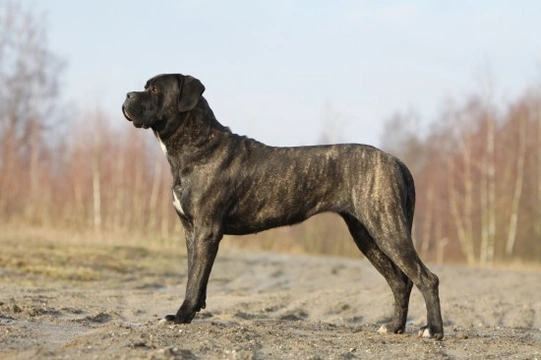
Does the Cane Corso dog make a good pet?
The Cane Corso is a large Italian dog from the mastiff/Molosser grouping, and is also one of the ancestral breeds of the Neapolitan mastiff, a breed that is often confused with the Cane Corso! While like all mastiffs, the Cane Corso is large and muscular, it is one of the lighter weight dogs of the mastiff breeds, and is sinewy rather than bulky in build. The Cane Corso can stand up to 28” tall at the shoulder, and weigh in at up to 110lb. It is thought that the Cane Corso is one of the oldest of the mastiff breeds, and is also the last known true coursing mastiff, and the breed standard dictates that the Cane Corso should be powerful and athletic, rather than lumbering and heavy.
They are handsome, noble looking dogs that hold the distinction of being protective but not aggressive, and for this reason, they are popular in many countries including the UK in the dual role of guard dog and family pet. If you are wondering if the Cane Corso might be the right choice of dog for you, this article will provide you with some more information about the breed’s core traits and temperament. Read on to learn more!
Cane Corso dogs and their role throughout history
The Cane Corso is a descendent of the now extinct Molossian War Dog, which was originally bred in the ancient Greek state of Molossus. The Cane Corso has a rather dark and grim history from its war days, and rumour has it that the breed were set against their enemies with buckets of boiling oil strapped to their backs. Later on, the Cane Corso became a popular breed in rural areas, for cattle herding, property guarding and helping to hunt for food. The breed almost came to extinction in the 20th Century, but a concerted effort to save the breed in its home country of Italy raised the breed’s numbers, and the breed was first exported abroad on a large scale during the 1980’s. Today, the breed is recognised by all of the major international Kennel Clubs.
Guarding temperament
The Cane Corso is classed as a giant breed, although they are one of the smaller breeds within the mastiff group. They are physically large and imposing, and tend to fill the available space and draw the eye, thanks to their large head and neck and tall size. They are excellent guard dogs, and just the sight of a barking Cane Corso is enough to make most would-be intruders think twice about carrying on! While they do make for excellent guard dogs and deterrents, they are actually generally very laid back and chilled out dogs, and will tend to be indifferent and uninterested in strangers rather than aggressive.
The Cane Corso is incredibly loyal to their families, and are renowned for being good with even small children, with whom they are generally very gentle. It can take a reasonable amount of time to gain the love and respect of the Cane Corso, but once you have earned it, you will have a friend for life.
Cane Corso health and longevity
The average longevity of the breed as a whole is around ten years, and they are prone to certain genetically inherited health problems that recur time and again across the breed as a whole.
Like all large and giant dog breeds with deep chests, they have elevated risk factors for bloat and GDV, a very serious condition that comes on quickly and can prove fatal. They are also at potential risk of hereditary heart disease, and hip and elbow dysplasia.
Due to their wrinkled faces and drooping eyes, they may be prone to eye problems too, including cataracts, eye infections and retinal problems, as well as potentially ingrown eyelashes, which can prove very painful and irritating to the dog, and which may require surgical correction.
Is a Cane Corso the right choice of dog for you?
If you have never owned a dog before and are not an experienced dog handler, then the Cane Corso is probably not the perfect choice for you. They tend to be headstrong, confident and potentially dominant if they are not handled fairly and firmly, and will soon take the alpha role if they do not receive clear leadership from their owner.
It is vitally important to begin training and socialising the Cane Corso from a young age, in order to ensure that they are able to get on well with other dogs and people, and do not become dominant or aggressive.
While they are quiet dogs within the home and are not among the most energetic and lively of dog breeds, due to their large size, they do still require a couple of long walks each day, and plenty of opportunities to stretch their legs and work off their excess energy levels.



